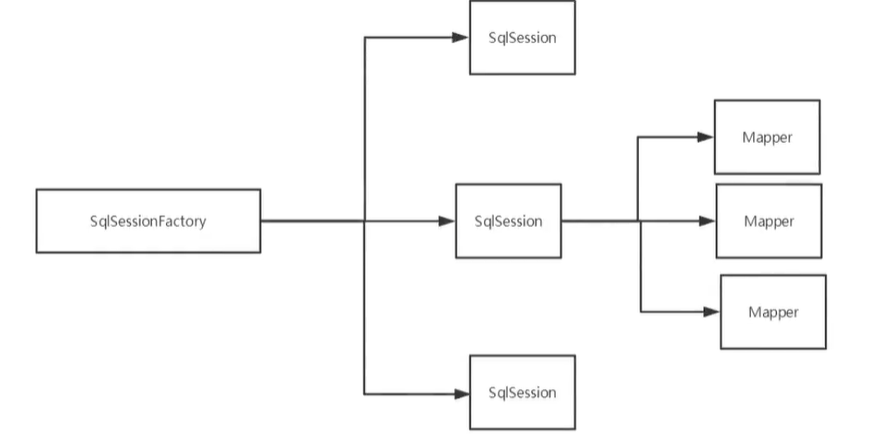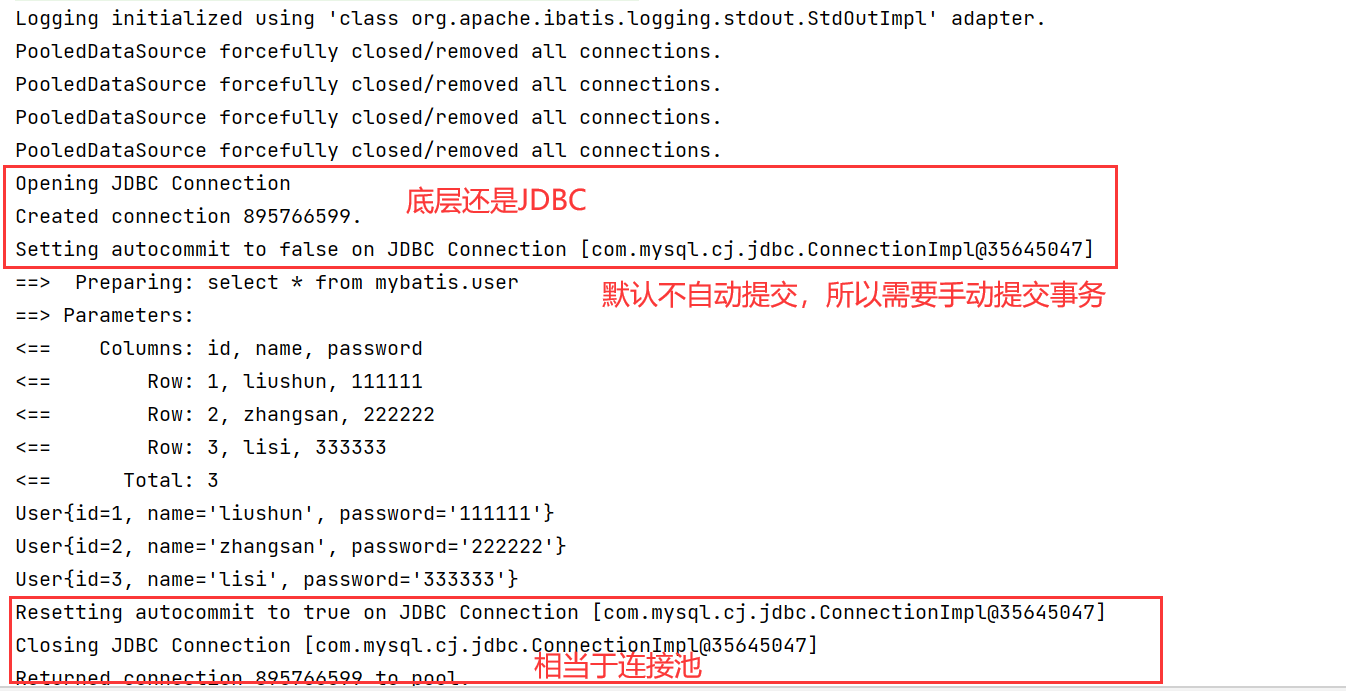Mybatis
简介
概念
MyBatis 是一款优秀的持久层框架,它支持自定义 SQL、存储过程以及高级映射。
MyBatis 免除了几乎所有的 JDBC 代码以及设置参数和获取结果集的工作。
MyBatis 可以通过简单的 XML 或注解来配置和映射原始类型、接口和 Java POJO(Plain Old Java Objects,普通老式 Java 对象)为数据库中的记录。
官网
https://mybatis.org/mybatis-3/zh/getting-started.html
jar包
<!-- https://mvnrepository.com/artifact/org.mybatis/mybatis -->
<dependency>
<groupId>org.mybatis</groupId>
<artifactId>mybatis</artifactId>
<version>3.5.7</version>
</dependency>
持久化和持久层
持久化是一个操作,持久层是一个名词
持久化是指将数据保存到文件或者数据库中,持久层是进行操作持久化的地方
第一个Mybatis程序
驱动配置
<!-- mysql 驱动 -->
<dependency>
<groupId>mysql</groupId>
<artifactId>mysql-connector-java</artifactId>
<version>8.0.26</version>
</dependency>
<!-- mybatis 驱动-->
<!-- https://mvnrepository.com/artifact/org.mybatis/mybatis -->
<dependency>
<groupId>org.mybatis</groupId>
<artifactId>mybatis</artifactId>
<version>3.5.7</version>
</dependency>
<!-- junit 单元测试 -->
<dependency>
<groupId>junit</groupId>
<artifactId>junit</artifactId>
<version>4.12</version>
<scope>test</scope>
</dependency>
由于maven约定大于配置,所以需要配置resources 防止资源导出失败
<build>
<resources>
<resource>
<directory>src/main/resources</directory>
<includes>
<include>**/*.properties</include>
<include>**/*.xml</include>
</includes>
<filtering>true</filtering>
</resource>
<resource>
<directory>src/main/java</directory>
<includes>
<include>**/*.properties</include>
<include>**/*.xml</include>
</includes>
<filtering>true</filtering>
</resource>
</resources>
</build>
mybatis工具类,相当于JDBC中的PreparedStatement,用来执行数据库操作
SqlSession 提供了在数据库执行 SQL 命令所需的所有方法
//获得SqlSession对象
public class MybatisUtils {
private static SqlSessionFactory sqlSessionFactory;
static {
try {
//获得SqlSessionFactory实例
String resource = "mybatis-config.xml";
InputStream inputStream = Resources.getResourceAsStream(resource);
sqlSessionFactory = new SqlSessionFactoryBuilder().build(inputStream);
} catch (IOException e) {
e.printStackTrace();
}
}
//既然有了 SqlSessionFactory,顾名思义,我们可以从中获得 SqlSession 的实例。
// SqlSession 提供了在数据库执行 SQL 命令所需的所有方法。你可以通过 SqlSession 实例来直接执行已映射的 SQL 语句
public static SqlSession getSqlSession(){
return sqlSessionFactory.openSession();
}
}
编写UserMapper.xml来代替UserMapper接口的实现类
<?xml version="1.0" encoding="UTF8"?>这里要是UTF8不能有-
<!DOCTYPE mapper
PUBLIC "-//mybatis.org//DTD Mapper 3.0//EN"
"http://mybatis.org/dtd/mybatis-3-mapper.dtd">
<!--namespace 唯一绑定dao的接口-->
<mapper namespace="com.shun.dao.UserMapper">
<select id="getUserList" resultType="com.shun.pojo.User">
select * from mybatis.user
</select>
</mapper>
重要的是mybatis-config.xml的配置每一个Mapper.xml文件,都需要注册,最好使用绝对路径
<?xml version="1.0" encoding="UTF-8" ?>
<!DOCTYPE configuration
PUBLIC "-//mybatis.org//DTD Config 3.0//EN"
"http://mybatis.org/dtd/mybatis-3-config.dtd">
<configuration>
<environments default="development">
<environment id="development">
<transactionManager type="JDBC"/>
<dataSource type="POOLED">
<property name="driver" value="com.mysql.cj.jdbc.Driver"/>
<property name="url" value="jdbc:mysql://localhost:3306/mybatis?useSSL=true&userUnicode=true&characterEncoding=UTF-8"/>
<property name="username" value="root"/>
<property name="password" value=".20010404liushun"/>
</dataSource>
</environment>
</environments>
<mappers>
<mapper resource="com/shun/dao/UserMapper.xml"/>
</mappers>
</configuration>
CRUD
增删改必须要提交事务才能真正写入数据库
mybatis是默认开启事务的,并且是默认不自动提交的
==参数一般用Map来实现,而不是使用对象==
//获得对象
SqlSession sqlSession = MybatisUtils.getSqlSession();
//执行
UserMapper mapper = sqlSession.getMapper(UserMapper.class);
int ddd = mapper.addUser(new User(4, "ddd", "1111111"));
sqlSession.commit();
sqlSession.close();
配置解析
核心文件配置
db.properties
driver=com.mysql.cj.jdbc.Driver
url=jdbc:mysql://localhost:3306/mybatis?useSSL=true&userUnicode=true&characterEncoding=UTF-8
username=root
password=.20010404liushun
mybatis-config.xml
<!-- 引入外部配置文件 -->
<properties resource="db.properties"/>
映射器
<!-- 使用相对于类路径的资源引用 -->
<mappers>
<mapper resource="org/mybatis/builder/AuthorMapper.xml"/>
<mapper resource="org/mybatis/builder/BlogMapper.xml"/>
<mapper resource="org/mybatis/builder/PostMapper.xml"/>
</mappers>
<!-- 使用映射器接口实现类的完全限定类名 -->
<mappers>
<mapper class="org.mybatis.builder.AuthorMapper"/>
<mapper class="org.mybatis.builder.BlogMapper"/>
<mapper class="org.mybatis.builder.PostMapper"/>
</mappers>
<!-- 将包内的映射器接口实现全部注册为映射器 -->
<mappers>
<package name="org.mybatis.builder"/>
</mappers>
后面两种方式要求:
实体类和Mapper配置文件必须同名且在同一包下
生命周期和作用域

作用域和生命周期类别是至关重要的,因为错误的使用会导致非常严重的并发问题
SqlSessionFactoryBuilder
一旦创建了 SqlSessionFactory,就不再需要它
局部变量
SqlSessionFactory
说白了就是数据库连接池
SqlSessionFactory 一旦被创建就应该在应用的运行期间一直存在,没有任何理由丢弃它或重新创建另一个实例
因此 SqlSessionFactory 的最佳作用域是应用作用域
最简单的就是使用单例模式或者静态单例模式
SqlSession
等价于连接到连接池的一个请求
SqlSession 的实例不是线程安全的,因此是不能被共享的,所以它的最佳的作用域是请求或方法作用域
用完之后需要立即关闭,否则就会一直占用资源
换句话说,每次收到 HTTP 请求,就可以打开一个 SqlSession,返回一个响应后,就关闭它

每一个Mapper,就代表一个具体的业务
结果集映射
解决字段名和属性名不一致的问题
有两种方式
- 取类型别名
- resultMap:只需要映射不同的名称即可
方式一
<select id="selectUsers" resultType="User">
select
user_id as "id",
user_name as "userName",
hashed_password as "hashedPassword"
from some_table
where id = #{id}
</select>
方式二
<resultMap id="userResultMap" type="User">
<id property="id" column="user_id" />
<result property="username" column="user_name"/>
<result property="password" column="hashed_password"/>
</resultMap>
<select id="selectUsers" resultMap="userResultMap">
select user_id, user_name, hashed_password
from some_table
where id = #{id}
</select>
日志

STDOUT_LOGGING 标准日志输出
配置文件
<settings>
<setting name="logImpl" value="STDOUT_LOGGING"/>
</settings>

log4j
概念
Log4j是Apache的一个开源项目,通过使用Log4j,我们可以控制日志信息输送的目的地是控制台、文件、GUI组件;
我们也可以控制每一条日志的输出格式;
通过定义每一条日志信息的级别,我们能够更加细致地控制日志的生成过程
这些可以通过一个配置文件来灵活地进行配置,而不需要修改应用的代码
依赖
<!-- https://mvnrepository.com/artifact/log4j/log4j -->
<dependency>
<groupId>log4j</groupId>
<artifactId>log4j</artifactId>
<version>1.2.17</version>
</dependency>
配置文件
#将等级为DEBUG的日志信息输出到console和file这两个目的地
log4j.rootLogger = DEBUG, console, file
#控制台输出的相关设置
log4j.appender.console = org.apache.log4j.ConsoleAppender
log4j.appender.console.Target = System.out
log4j.appender.console.threshold = DEBUG
log4j.appender.console.layout = org.apache.log4j.PatternLayout
log4j.appender.console.layout.ConversionPattern = [%c]-%m%n
#文件输出的相关设置
log4j.appender.file = org.apache.log4j.RollingFileAppender
log4j.appender.file.File = ./log/shun.log
log4j.appender.file.MaxFileSize = 10mb
log4j.appender.file.threshold = DEBUG
log4j.appender.file.layout = org.apache.log4j.PatternLayout
log4j.appender.file.layout.ConversionPattern = [%p][%d{yy-mm-dd}][%c]%m%n
#日志输出级别
log4j.logger.org.mybatis = DEBUG
log4j.logger.java.sql = DEBUG
log4j.logger.java.sql.Statement = DEBUG
log4j.logger.java.sql.ResultSet = DEBUG
log4j.logger.java.sql.PreparedStatement = DEBUG
简单使用
导入包
import org.apache.log4j.Logger;
获得对象,参数为当前类的class
Logger logger = Logger.getLogger(UserMapperTest.class);
使用
logger.info("info");
logger.debug("debug");
logger.error("error");
分页
接口
//分页查询用户
List<User> getUserByLimit(HashMap<String, Integer> map);
xml
<select id="getUserByLimit" parameterType="map" resultType="com.shun.pojo.User">
select * from user limit #{startIndex}, #{pageSize}
</select>
测试
SqlSession sqlSession = MybatisUtils.getSqlSession();
UserMapper mapper = sqlSession.getMapper(UserMapper.class);
HashMap<String, Integer> stringIntegerHashMap = new HashMap<>();
stringIntegerHashMap.put("startIndex", 1);
stringIntegerHashMap.put("pageSize", 2);
List<User> userByLimit = mapper.getUserByLimit(stringIntegerHashMap);
for (User user : userByLimit) {
System.out.println(user);
}
sqlSession.close();
多对一处理
学生实体类包含老师实体类对象
方式一相当于子查询,方式二为联表查询
<! --思路:
1.查询所有的学生信息
2.根据查询出来的学生的tid,寻找对应的老师!
-->
<select id="getstudent" resu1tMap="StudentTeacher">
select * from student
</select>
<resultMap id="StudentTeacher" type="Student">
<result property="id" column="id" />
<result property="name" column="name" / >
<!--复尔的属性,我们需要单独处理 对象:association,集合:collection -->
<association property="teacher" column="tid" javAType="Teacher" select="getTeacher" />
</resu1tMap>
<select id="getTeacher" resultType="Teacher">
select * from teacher where id =#{id}
</select>
<!--按照结果嵌套处理-->
<select id="getStudent2" resultMap="StudentTeacher2">
select s.id sid,s.name sname,t.name tname
from student s,teacher t
where s.tid = t.id;
</select>
<resultMap id="StudentTeacher2" type="Student">
<result property="id" column="sid"/>
<result property="name" column="sname" / >
<association property="teacher" javaType="Teacher">
<result property="name" column="tname"/>
</association>
</resultMap>
老师实体类里面有一个学生实体类的list
<!--按结果欣套查询-->
<select id="getTeacher" resultMap="TeacherStudent">
select s.id sid, s.name sname,t.name tname,t.id tidfrom student s,teacher t
where s.tid = t.id and t.id = #{tid}
</select>
<resultMap id="TeacherStudent" type="Teacher">
<result property="id" column="tid"/>
<result property="name" column="tname" / >
<!--复杂的属性,我们需要单独处理对象:association 集合: collectionjavaType=""指定属性的类型!
集合中的泛型信息,我们使用ofType获取-->
<collection property="students" ofType="Student">
<result property="id" column="sid"/>
<result property="name" column="sname"/ ><result property="tid" column="tid" />
</collection>
</resultMap>
javaType & ofType
- JavaType用来指定实体类中属性的类型
- ofType用来指定映射到List或者集合中的pojo类型,泛型中的约束类型!
动态SQL
概念
指根据不同的条件生成不同的SQL语句
传递参数
一般是一个hashMap<String, String>
if
参数传入title,就追加if语句内容
if语句可重复使用
<select id="findActiveBlogWithTitleLike"
resultType="Blog">
SELECT * FROM BLOG
WHERE state = ‘ACTIVE’
<if test="title != null">
AND title like #{title}
</if>
</select>
Choose、When、Otherwise
只会选择一个,当title成立,就优先title,如果都没有就选择otherwise
<select id="findActiveBlogLike"
resultType="Blog">
SELECT * FROM BLOG WHERE state = ‘ACTIVE’
<choose>
<when test="title != null">
AND title like #{title}
</when>
<when test="author != null and author.name != null">
AND author_name like #{author.name}
</when>
<otherwise>
AND featured = 1
</otherwise>
</choose>
</select>
Where、Set、trim
where标签可以去除开头多余的and,
set标签可以去除末尾多余的逗号,
trim自定义标签
<select id="findActiveBlogLike"
resultType="Blog">
SELECT * FROM BLOG
<where>
<if test="state != null">
state = #{state}
</if>
<if test="title != null">
AND title like #{title}
</if>
<if test="author != null and author.name != null">
AND author_name like #{author.name}
</if>
</where>
</select>
<!--与where等价的自定义标签 -->
<trim prefix="WHERE" prefixOverrides="AND |OR ">
...
</trim>
<update id="updateAuthorIfNecessary">
update Author
<set>
<if test="username != null">username=#{username},</if>
<if test="password != null">password=#{password},</if>
<if test="email != null">email=#{email},</if>
<if test="bio != null">bio=#{bio}</if>
</set>
where id=#{id}
</update>
<!--与set等价的自定义标签 -->
<trim prefix="SET" suffixOverrides=",">
...
</trim>
foreach
foreach 元素的功能非常强大,它允许你指定一个集合,声明可以在元素体内使用的集合项(item)和索引(index)变量。它也允许你指定开头与结尾的字符串以及集合项迭代之间的分隔符。这个元素也不会错误地添加多余的分隔符
你可以将任何可迭代对象(如 List、Set 等)、Map 对象或者数组对象作为集合参数传递给 foreach。当使用可迭代对象或者数组时,index 是当前迭代的序号,item 的值是本次迭代获取到的元素。当使用 Map 对象(或者 Map.Entry 对象的集合)时,index 是键,item 是值。
<select id="selectPostIn" resultType="domain.blog.Post">
SELECT *
FROM POST P
WHERE ID in
<foreach item="item" index="index" collection="list"
open="(" separator="," close=")">
#{item}
</foreach>
</select>